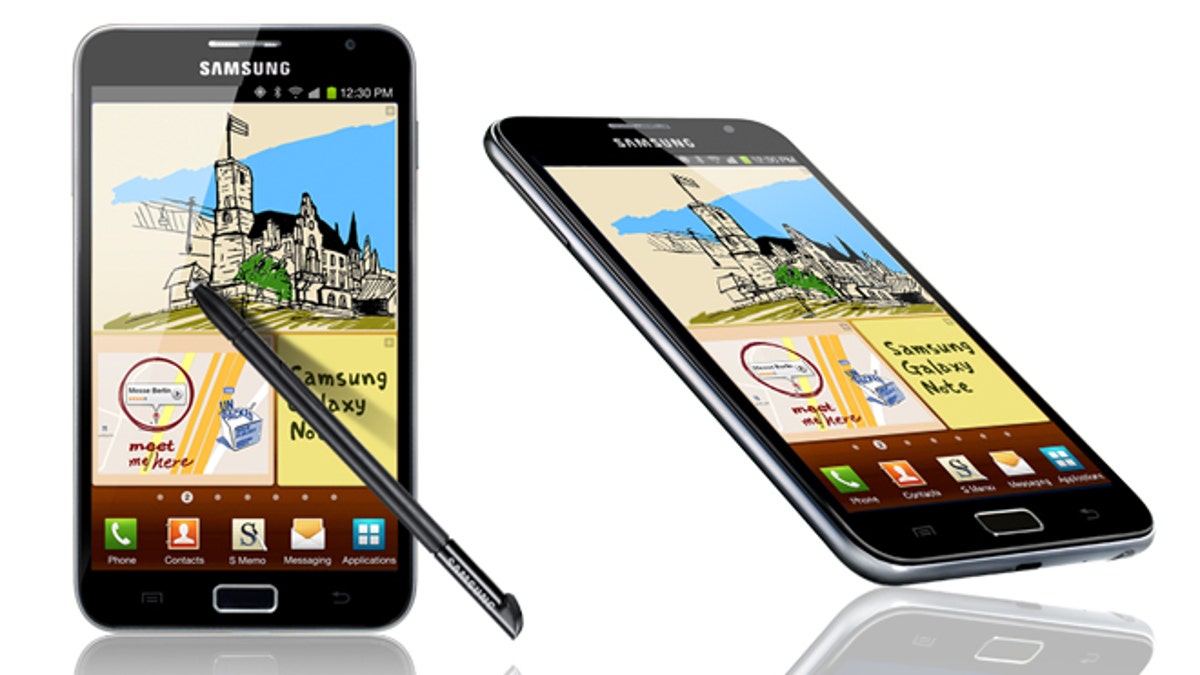
The Samsung Galaxy Note, a 5.3-inch smartphone so large that some are dubbing it a "super phone." (Samsung)
Faster than a desktop computer! Nimbler than an iPad! It's not a phone, it's not a tablet. It's super phone!
Rather than getting smaller, smartphones are getting bigger -- and more powerful. At the Mobile World Congress in Barcelona this week, the annual coming out party for new mobile handsets, the trend is clear -- but are people ready for these brawny, Brobdingnagian beasts?
The first super phone to make a major debut in the U.S. is Samsung's Galaxy Note, and it's a risk taker. Introduced earlier this month on AT&T, the phone commands a premium price -- $299.99 with a two-year contract -- but it boasts a massive 5.3-inch screen (diagonal). Compare that to an iPhone's now puny looking 3.5-inch screen.
Super phones are partly an acknowledgement of how people are using smart phones these days. They're making fewer voice calls and making more Facebook posts and text messages. Most people use apps for finding a restaurant, uploading a picture or checking in to a coffee shop rather than calling home.
Phones are now cameras, video shooters, and portable TVs. But is a bigger screen -- and consequently bulkier 6.5-ounce handset -- the best way to cater to these uses?
After more than a week traveling with the Samsung Galaxy Note, I found my initial skepticism turned to appreciation.
The phone's dual-core processor is zippy, and it uses AT&T's faster 4G LTE network, which is now available in nearly 30 U.S. markets. I got a 4G connection in some surprising places, such as the ex-urbs around our nation's capital.
The Galaxy Note also has 16 GB of storage, which is expandable using a microSD card to 32 GB. And there's a rear-facing 8-megapixel camera that can shoot high-definition video, and a front-facing 2-megapixel camera for video calls.
The main attraction, however, is the screen. It's a high-definition Super Amoled display that is not only big but also crisp and visible in direct sunlight (its technical resolution is 1,280 by 800 pixels). The display also doesn't put an onerous burden on the battery. I was able to spend an entire day playing tourist, getting directions, checking out Google Goggles listings for popular attractions, checking e-mail, idling away empty minutes surfing the Web, and, yes, making phone calls without having to search for a charging outlet.
In toto, the experience was definitely favorable. The larger touch screen is a great for scanning Web sites: You don't have to constantly pinch and expand pages to see them clearly. It's also excellent for watching Netflix videos when you have to cure a bout of insomnia. And it's a better size for reading ebooks in Google Books while commuting.
An editor sent me a PDF file to proofread, I was able to see it without constantly sliding the page from side to side. Moreover, middle-aged smartphone users will also find it easier to navigate and play games on the Galaxy Note without squinting.
The drawbacks of the larger phone were few. When making a phone call, the Galaxy Note can make you feel like Agent 86, holding his shoe phone up to his ear. Subtle, it ain't. But most people use their phones for everything but making a phone call, and many also use wireless Bluetooth earpieces, obviating the need to hold it to your ear.
Some users I canvased, mostly women, complained that they couldn't tap in codes and numbers with just one hand. I didn't have the same problem, but I did find that the larger phone necessitated a jacket pocket, rather than fitting into a pants pocket.
Samsung is also trying an old trick on the new phone: It includes a stylus, that tucks neatly into the bottom of the device. Unlike the Palm Pilot pens of the past, however, Samsung's version uses more sophisticated technology from Wacom, which makes it pressure sensitive. It also has a special function button on the side that can be used for invoking a note pad app for storing doodles or reminders (no more paper napkins). While the S pen, as Samsung calls it, opens up some interesting future possibilities, I found I mostly ignored it and just used the device like a normal touch screen phone.
Enlarged smartphones have been tried before. Dell's ill-fated Streak 5 turned out to have no clothes, at least as far as most shoppers were concerned. But that device was chubby. The Samsung Galaxy Note is slim and sexy.
In the coming months, there will be a new wave of super phones. HTC is introducing the One X, with a 4.7-inch screen and a faster and sharper 8-megapixel camera that will be available on T-Mobile. And Nokia has shown what it calls a 41-megapixel camera phone in Barcelona (think of the data charges!).
Meanwhile, LG is pushing faster chips, announcing a quad-core processor phone, the Optimus 4X HD. It all continues a trend of mobile phones that put the power of a desktop computer in your pocket.
Certainly there are some people who will welcome a super phone like the Samsung Galaxy Note and consider it to be a Goldilocks device: Big enough to effectively surf the Web and read and write on, but small enough to fit in a jacket pocket or purse. The question is, will there be enough of those customers willing to pay $300?
Follow John R. Quain on Twitter @jqontech or find more tech coverage at J-Q.com.




















